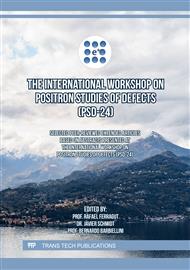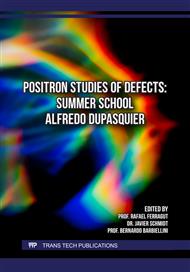[1]
Positron and positronium chemistry. Eds. D.M. Schrader and Y.C. Jean. Elsevier, Amsterdam, (1988)
Google Scholar
[2]
O.E. Mogensen Positron annihilation in chemistry, Springer-Verlag, Berlin, (1995)
Google Scholar
[3]
Principles and applications of positron and positronium chemistry. Eds. Y.C. Jean, P.E. Mallone, and D.M. Schrader (World Scientific Publications, Singapore, 2003)
Google Scholar
[4]
S.V. Stepanov, V.M. Byakov, D.S. Zvezhinskiy, G. Duplâtre, R.R. Nurmukhametov, P.S. Stepanov "Positronium in a Liquid Phase: Formation, Bubble State and Chemical Reactions". Advances in Physical Chemistry. V. 2012 (2012) Article ID 431962 dx.doi.org/
DOI: 10.1155/2012/431962
Google Scholar
[5]
M. Petriska, S. Sojak, V. Kršjak, V. Slugeň "Digital triple coincidence positron lifetime setup with DRS4 and its benefits". AIP Conf. Proc. V.2411, 080009 (2021)
DOI: 10.1063/5.0067492
Google Scholar
[6]
L. Onsager "Initial Recombination of Ions". Phys. Rev. V.54 (1938), pp.554-557
DOI: 10.1103/PhysRev.54.554
Google Scholar
[7]
V.M. Byakov, S.V. Stepanov "Common features in the formation of Ps, Mu, radioltic hydrogen and solvated electrons in aqueous solutions". Journal of Radioanalytical and Nuclear Chemistry. V. 210(2) (1996), pp.371-405
DOI: 10.1007/BF02056379
Google Scholar
[8]
S.V. Stepanov, V.M. Byakov "Slowing down of positrons and muons in ordinary and heavy water. Formation probabilities of Ps, H2 and Mu". Materials Science Forum Vol. 255-257 (1997), pp.287-289
DOI: 10.4028/www.scientific.net/MSF.255-257.287
Google Scholar
[9]
J. Dryzek, P. Horodek "The distribution of slowing-down times of positrons emitted from 22Na and 68Ge-68Ga isotopes into metals". Materials Science Forum Vol. 666 (2011), pp.10-14
DOI: 10.4028/www.scientific.net/MSF.666.10
Google Scholar
[10]
S.V. Stepanov, V.M. Byakov "Physical and Radiation Chemistry of the Positron and Positronium", in the book Principles and Applications of Positron and Positronium Chemistry, eds. Y.C. Jean, P.E. Mallone, D.M. Schrader. Chapter 5, pp.117-149. World Scientific Publications, Singapore (2003).
DOI: 10.1142/9789812775610_0005
Google Scholar
[11]
Stepanov S.V., Byakov V.M., Wang C.-L., Kobayashi Y., Hirata K. "Electric field effect on Ps formation. Black blob model". Material Science Forum, v.363-365, pp.392-394, 2001
DOI: 10.4028/www.scientific.net/MSF.363-365.392
Google Scholar
[12]
S.V. Stepanov, V.M. Byakov, Y. Kobayashi "Ps Formation in Molecular Media: Effect of the External Electric Field". Phys. Rev. B. V. 71(5) (2005), 054205
DOI: 10.1103/PhysRevB.72.054205
Google Scholar
[13]
S.V. Stepanov, V.M. Byakov "Ps formation in molecular media: low temperature hydrocarbons". Phys. Stat. Sol. (c). V. 4(10) (2007), pp.3684-3689
DOI: 10.1002/pssc.200675758
Google Scholar
[14]
W.Teutsch, V.Hughes "Effect of an electric field on positronium formation in gases: Theoretical". Phys. Rev. V. 103(5) (1956), pp.1266-1281
DOI: 10.1103/PhysRev.103.1258
Google Scholar
[15]
S.V. Stepanov, V.M. Byakov "Electric field effect on Ps formation in liquids". J. Chem. Phys. V. 116(4) (2002), pp.6178-6195
DOI: 10.1063/1.1451244
Google Scholar
[16]
Handbook of Radiation Chemistry, edited by Y. Tabata, Y. Ito, S. Tagawa. CRC Press, Boca Raton (1991)
Google Scholar
[17]
J.M. Wiesenfeld, E.P. Ippen "Dynamics of electron solvation in liquid water'. Chem. Phys. Lett. V. 73(1) (1980), pp.47-50
DOI: 10.1016/0009-2614(80)85199-2
Google Scholar
[18]
E.J. Hart, M. Anbar The Hydrated Electron. Wiley-Inter-science, New York (1970).
Google Scholar
[19]
Radiation chemistry: from basics to applications in material and life science, ed. by J. Belloni, M. Mostafavi, T. Douki, M. Spotheim-Maurizot. Les Ulis: EDP Sciences, 2008. 307 p. ISBN 978-2-7598-0024-7
DOI: 10.1051/978-2-7598-0024-7
Google Scholar
[20]
M. Domae, Y. Katsumura, K. Ishigure, V.M. Byakov "Modelling of Primary Chemical Processes of Water Radiolysis and Simulation by Spur Diffusion Model". Radiat. Phys. Chem. V. 48(4) (1996), pp.487-495
DOI: 10.1016/0969-806X(96)00060-6
Google Scholar
[21]
V.M. Byakov, F.G. Nichipirov Intratrack chemical processes. EnergoAtomIzdat, Moscow (1985).
Google Scholar
[22]
V.M. Byakov, V.I. Grafutin "Positronium in radiation chemistry of liquids". Int. J. of Radiation Applications and Instrumentation. Part C. Radiation Physics and Chemistry. V. 28(1) (1986), pp.1-18
DOI: 10.1016/1359-0197(86)90031-7
Google Scholar
[23]
R.K. Wolff, M.J. Bronskill, J.W. Hunt "Picosecond Pulse Radiolysis Studies. II. Reactions of Electrons with Concentrated Scavengers". J. Chem. Phys. V. 53(11) (1970), p.4211
DOI: 10.1063/1.1673923
Google Scholar
[24]
O.A. Anisimov, Yu.N.Molin Proc. 4th Int. Conf. Positron Annihilation, Helsinger, Danmark, G31, (1976)
Google Scholar
[25]
S.V. Stepanov, G. Duplâtre, V.M. Byakov, D.S. Zvezhinskiy, V.S. Subrahmanyam "Formation of quasifree and bubble positronium states in water and aqueous solutions". Acta Physica Polonica A. V. 125(3) (2014), pp.770-774
DOI: 10.12693/APhysPolA.125.770
Google Scholar
[26]
P.S. Stepanov, F.A. Selim, S.V. Stepanov, A.V. Bokov, O.V. Ilyukhina, G. Duplâtre, V.M. Byakov "Interaction of positronium with dissolved oxygen in liquids", Physical Chemistry Chemical Physics. V. 22 (2020), pp.5123-5131
DOI: 10.1039/C9CP06105C
Google Scholar
[27]
K.V. Mikhin, S.V. Stepanov, V.M. Byakov "Formation of the Ps Bubble in Liquid Media". Radiat. Phys. Chem. V. 68 (2003), pp.415-417
DOI: 10.1016/S0969-806X(03)00193-2
Google Scholar
[28]
D.S. Zvezhinskiy, M. Butterling, A. Wagner, R. Krause-Rehberg, S.V. Stepanov "Account of the intratrack radiolytic processes for interpretation of the AMOC spectrum of liquid water". Journal of Physics: Conference Series. V. 443 (2013) 012057
DOI: 10.1088/1742-6596/443/1/012057
Google Scholar
[29]
R.A. Ferrel "Long lifetime of positronium in liquid helium". Phys. Rev. V. 108 (1957), pp.167-168 doi.org/
DOI: 10.1103/PhysRev.108.167
Google Scholar
[30]
M. Eldrup, D. Lightbody, J.N. Sherwood "The temperature dependence of positron lifetimes in solid pivalic acid". Chem. Phys. V. 63 (1981), pp.51-58 http://dx.doi.org/10.1016/0301- 0104(81)80307-2
DOI: 10.1016/0301-0104(81)80307-2
Google Scholar
[31]
S.V. Stepanov, D.S. Zvezhinski, G. Duplâtre, V.M. Byakov, Yu.Yu. Batskikh, P.S. Stepanov "Incorporation of the Magnetic Quenching Effect into the Blob Model of Ps Formation. Finite Sized Ps in a Potential Well". Materials Science Forum Vol. 666 (2011) pp.109-114
DOI: 10.4028/www.scientific.net/MSF.666.109
Google Scholar
[32]
A. Bisi, G. Consolati, G. Gambarini, L. Zappa "Perturbation on positronium hyperfine splitting from diamagnetic ions", Nuovo Cimento, 5D (1985), p.358
DOI: 10.1007/BF02451256
Google Scholar
[33]
I. Billard, J.-Ch. Abbe, G. Duplâtre: Chem. Physics. V. 127 (1988), p.273
DOI: 10.1016/0301-0104(94)00074-3
Google Scholar
[34]
S.V. Stepanov, V.M. Byakov, G. Duplâtre, D.S. Zvezhinskiy, Yu.V. Lomachuk "Positronium formation in a liquid phase: Influence of intratrack reactions and temperature". Phys. Status Solidi C. V. 6(11) (2009), pp.2476-2481
DOI: 10.1002/pssc.200982059
Google Scholar
[35]
V.B. Berestetsky, E.M. Lifshits, L.P. Pitaevskii "Quantum Electrodynamics". Volume 4 of Course of Theoretical Physics Second edition. 2d ed., Butterworth-Heinemann, 1982
DOI: 10.1016/B978-0-08-050346-2.50001-5
Google Scholar
[36]
V.W. Hughes, S. Marder, C.S. Wu Phys.Rev., V.106(5), pp.934-947 (1957)
Google Scholar



